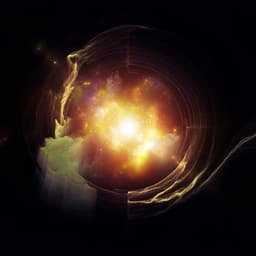
Space Sciences
A recently quenched galaxy 700 million years after the Big Bang
T. J. Looser, F. D'eugenio, et al.
This groundbreaking research uncovers a mini-quenched galaxy at redshift z = 7.3, only 700 million years after the Big Bang. Observed using JWST/NIRSpec, this galaxy shows signs of a recent halt in star formation, revealing exciting insights into the cosmic evolution as studied by authors from the Kavli Institute for Cosmology, University of Cambridge, among others.
~3 min • Beginner • English
Introduction
The study investigates whether galaxies in the early Universe experienced rapid, bursty star-formation histories with temporary quenching (mini-quenching), as predicted by theory for low-mass systems at high redshift. Observational confirmation has been challenging due to limitations in detecting Balmer breaks and weak emission lines at z > 5 prior to JWST. The purpose is to directly identify and characterize a quenched or mini-quenched galaxy during the epoch of reionization, constraining star-formation histories, current star-formation activity, and potential quenching mechanisms. The significance lies in testing models of galaxy evolution and feedback in a pivotal mass regime where transitions between bursty and stable star formation are expected and where multiple feedback processes may operate.
Literature Review
Previous works identified quenched or Balmer-break galaxies out to z < 5, typically massive and relatively old (for example, Nature 2017; ApJ 2020; CEERS JWST analyses). Photometric studies at z ≥ 6 proposed evolved stellar populations and potential quiescent phases but lacked spectroscopic confirmation, as strong emission lines can mimic Balmer breaks and ground-based facilities cannot access rest-frame optical beyond 2.5 μm at z > 5. UVJ color selection can misclassify fast-quenched systems; color-based criteria alone would have labeled this galaxy as star-forming. Simulations and studies suggest bursty star formation and mini-quenching at high redshift and in dwarfs, but observational constraints were scarce. The paper builds on these by using JWST/NIRSpec to provide spectroscopic confirmation of quenching at z ≈ 7.3.
Methodology
- Target selection and observations: The galaxy JADES-GS+53.15508-27.80178 (JADES-GS-z7-01-QU) was pre-selected via the photometric Lyman dropout technique with blue rest-frame UV color and observed with deep (28-hour) JWST NIRSpec multi-shutter array (MSA) prism spectroscopy (R≈100). A medium-resolution spectrum was also obtained to confirm the absence of emission lines.
- Redshift determination: Redshift z = 7.29 ± 0.01 was measured using BEAGLE from the combined detection of the Lyα continuum break and the Balmer break in the spectrum.
- Emission-line constraints and SFR limits: 3σ upper limit on Hβ flux F(Hβ) < 6.1 × 10^−20 erg cm^−2 s^−1 implies SFR < 0.65 M⊙ yr^−1 averaged over the past 3–10 Myr (including dust). A stronger 3σ limit from [O III]λ5008, F([O III]λ5008) < 6.5 × 10^−20 erg cm^−2 s^−1, combined with conservative assumptions on [O III]/Hβ ratios for high-z galaxies, yields an SFR limit about five times lower than the Hβ-based limit. The absence of emission lines is independently confirmed at medium spectral resolution.
- Stellar continuum indicators: Measured UV slope β = −2.09 ± 0.09 (typical for 6 < z < 10), clear Balmer break, and Hβ absorption EW_Hβ = 4.8 ± 1.0 Å, together satisfying common spectroscopic post-starburst criteria.
- SED and full spectral fitting: Joint spectrophotometric modeling of the SED was performed with four independent codes (pPXF, BAGPIPES, BEAGLE, Prospector) to infer stellar mass, current SFR, star-formation history (SFH), dust attenuation, and stellar metallicity, marginalizing over modeling assumptions. pPXF fits to the continuum were used to assess stellar populations; the other codes included flexible SFHs and nebular components.
- Alternative scenarios evaluated: High LyC escape fraction (f_esc > 0.9) with recent star formation was tested with BEAGLE and found strongly disfavored relative to a quenched (>3–10 Myr) solution. Completely obscured star formation was considered but deemed unlikely given the low mass and lack of evidence for high dust masses/extinction at this redshift.
- Environment assessment: A search for nearby massive galaxies (Methods) found none, disfavoring environmental quenching for this object.
Key Findings
- Discovery: A spectroscopically confirmed quenched or mini-quenched galaxy at z = 7.3 (z = 7.29 ± 0.01), when the Universe was ~700 Myr old.
- Spectral diagnostics: Very blue continuum (U − V = 0.16 ± 0.03 mag), clear Balmer break, Hβ absorption with EW_Hβ = 4.8 ± 1.0 Å; no nebular emission lines detected in prism or medium-resolution spectra.
- Emission-line/SFR limits: 3σ limits F(Hβ) < 6.1 × 10^−20 erg cm^−2 s^−1 → SFR < 0.65 M⊙ yr^−1 (3–10 Myr timescale). F([O III]λ5008) < 6.5 × 10^−20 erg cm^−2 s^−1 → a 3σ SFR limit ≈5× stricter than the Hβ-based limit under conservative [O III]/Hβ assumptions.
- UV slope: β = −2.09 ± 0.09 indicates vigorous star formation within the past ~100 Myr preceding quenching.
- Stellar mass: M* = 4–6 × 10^9 M⊙, placing the object in the dwarf-galaxy regime.
- Star-formation history: A short starburst (duration ~20–100 Myr) formed most stars between ~100 and ~20 Myr before observation. Quenching occurred ~10–50 Myr before observation (code-dependent). Formation lookback times ~37–150 Myr; quenching lookback times ~16–50 Myr (pPXF ~50 Myr; BAGPIPES ~18 Myr; BEAGLE ~16 Myr; Prospector ~38 Myr).
- Current SFR and sSFR: Present SFR between 10^−2.6 and 10^−1.4 M⊙ yr^−1; sSFR between 10^−2.3 Gyr^−1 and 0.1 Gyr^−1, 2–3 orders of magnitude below the star-forming main sequence at this redshift and below the sSFR_10 threshold of 0.29 Gyr^−1, confirming quiescence at observation.
- Metallicity and dust: Three codes suggest low average stellar metallicity log10(Z/Z⊙) ≈ −2; BAGPIPES infers −0.7. pPXF indicates a minor enriched component (~5% mass) formed just before quenching. Effective dust attenuation A_V ≈ 0.1–0.5 mag depending on code.
- Color selection caveat: The object would be classified as star-forming by UVJ/colour cuts despite being quenched, underscoring the need for spectroscopy.
Discussion
The spectroscopic indicators (Balmer break, strong Balmer absorption, lack of emission lines) and stringent upper limits on emission lines collectively demonstrate that JADES-GS-z7-01-QU recently ceased star formation after a brief starburst. The present-day SFR and sSFR are far below the main sequence, meeting post-starburst/quiescent criteria at z ≈ 7.3. Alternative explanations were evaluated: a very high LyC escape fraction with ongoing very recent star formation is disfavored by spectral modeling (BEAGLE, as well as pPXF and Prospector which decouple continuum and nebular lines) and by the observed continuum slope and Balmer features. Completely obscured star formation cannot be fully excluded but is unlikely in such a low-mass, high-z system given the lack of evidence for high dust masses/extinction.
Potential quenching mechanisms are discussed in light of the galaxy’s mass and timescales. UV-background quenching is ruled out at this mass scale; environmental quenching appears unlikely due to the absence of nearby massive companions. A rapid ejective feedback event, likely driven by intense star formation and/or an accreting nascent supermassive black hole (AGN), could have expelled the star-forming gas quickly, consistent with the short SFH and low inferred metallicity. The system may be temporarily quenched (mini-quenched) and could rejuvenate if gas is replenished. Comparisons with cosmological simulations suggest bursty SFHs at early times, but current models struggle to produce fully quenched states for galaxies of this mass and often lack AGN feedback, highlighting the importance of this observation for constraining feedback models in the transition mass regime.
Conclusion
This work presents the discovery and spectroscopic confirmation of a (mini-)quenched, post-starburst dwarf-mass galaxy at z = 7.3, only ~700 Myr after the Big Bang. The continuum features and lack of emission lines imply a short, recent starburst followed by rapid quenching, with present SFR far below the main sequence. The findings challenge and inform theoretical models of early galaxy evolution and feedback, particularly in the mass range transitioning between bursty and stable star formation. Future JWST observations will enable moving from discovery to statistical characterization of the first mini-quenched galaxies, constraining the roles of stellar and AGN feedback and the frequency/duration of quenching episodes at cosmic dawn.
Limitations
- Spectral resolution and metallicity: Low-resolution prism spectroscopy limits precision in stellar metallicity estimates; metallicity inferences are therefore uncertain.
- Hidden star formation: Completely obscured star formation cannot be conclusively ruled out, though considered unlikely for a low-mass system at this epoch.
- Alternative high f_esc scenario: A very recent (<10 Myr) star-forming solution with high ionizing photon escape fraction is statistically disfavored but not impossible.
- Environmental assessment: While no nearby massive galaxies are identified, environmental effects cannot be ruled out absolutely given observational limits.
- Modeling assumptions: Results depend on SED-fitting assumptions and priors; different codes yield some dispersion in metallicity, dust, and timescales. Current simulations often omit AGN feedback in this mass regime, complicating direct theoretical comparisons.
Related Publications
Explore these studies to deepen your understanding of the subject.







